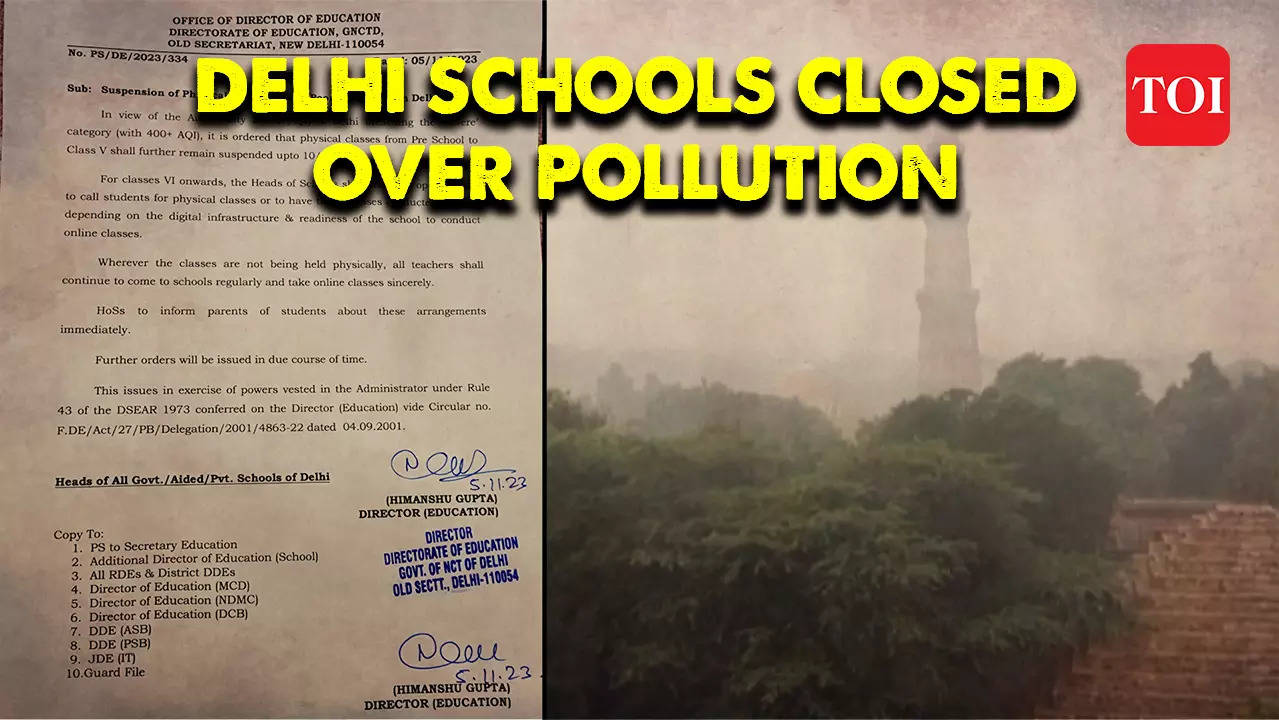


With Delhi and the NCR region facing severe air pollution levels, schools in Delhi and NCR have been closed and shifted to online classes for all students up to Class 12. The decision came after Stage IV of the Graded Response Action Plan was invoked in the NCR. This move has been followed by Tamil Nadu as well, with schools in five districts being closed due to heavy rainfall. However, the University of Delhi has refuted a fake circular announcing a winter holiday.
Delhi and NCR Battle Severe Air Pollution: Schools Closed, Online Classes Instituted
Delhi and the National Capital Region (NCR) have been grappling with alarming levels of air pollution, prompting authorities to take drastic measures to safeguard public health. As a result, all schools and colleges in the region have been closed, and students up to Class 12 have been shifted to online classes.
The decision to close educational institutions was made after Stage IV of the Graded Response Action Plan (GRAP) was invoked in the NCR. This stage mandates severe restrictions on construction activities, entry of trucks into Delhi, and other pollution-causing practices.
In addition to Delhi, Tamil Nadu has also been affected by severe weather conditions. Heavy rainfall has forced the closure of schools in five districts.
Meanwhile, the University of Delhi has dismissed a fake circular that announced a winter holiday. The university clarified that all academic and administrative activities will continue as per schedule.
Background
Air pollution has been a persistent problem in Delhi and the NCR for many years. The region's geography, coupled with high levels of vehicular traffic and industrial activities, contributes to the accumulation of pollutants in the air.
During the winter months, the situation often worsens due to unfavorable weather conditions. Cold temperatures trap pollutants near the ground, leading to a phenomenon known as "smog."
In recent years, the government has implemented various measures to combat air pollution, including:
Top 5 FAQs and Answers
1. What is the Graded Response Action Plan (GRAP)?
GRAP is a set of measures that are implemented based on the severity of air pollution levels. It includes five stages, each with progressively stricter restrictions. Stage IV is the most severe stage and involves measures such as school closures and restrictions on construction activities.
2. What is the difference between PM2.5 and PM10?
PM2.5 and PM10 refer to particulate matter with diameters of 2.5 micrometers and 10 micrometers, respectively. PM2.5 is considered more dangerous to human health as it can penetrate deeper into the lungs.
3. What are the health effects of air pollution?
Air pollution can cause a wide range of health problems, including:
4. What can individuals do to reduce air pollution?
5. What is the government doing to address air pollution?
The government has implemented various measures to combat air pollution, including:

Hospitals in the city have reported an increase in burn cases linked to the celebration of Diwali, with over a hundred cases reported at AIIMS Delhi alone. Despite the worsening air pollution, no major increase in respiratory distress cases was seen, but senior doctors anticipate an increase in the coming days. Several patients who suffered burns during the festival recounted how even seemingly harmless firecrackers resulted in severe injuries. While most cases were minor, a total of 129 patients were treated for firecracker-related injuries at Safdarjung Hospital.

Diwali, the festival of lights, is a celebration of good over evil and light over darkness. This festival is rooted in a rich history of mythological connections, with Hindus commemorating Lord Rama and his victory over the demon king Ravana. However, Diwali is not limited to just one faith - it is celebrated across beliefs and traditions, including Jains, Sikhs, and Newar Buddhists. Festivities and celebrations during this time include illuminations, rituals, feasting, and community gatherings, making it a time of joy, renewal, and gratitude.

Maharashtra Chief Minister Devendra Fadnavis honors the brave officers who sacrificed their lives in an ambush laid by Chinese troops in Ladakh. He pays respects at the martyrs' memorial on Police Commemoration Day, highlighting their inspiration for courage and integrity. The event is observed annually to remember the 10 valiant policemen who lost their lives in the line of duty.

Prime Minister Narendra Modi marked Diwali by joining the armed forces aboard INS Vikrant, India’s indigenous aircraft carrier. A cultural programme on the vessel, showcasing the creative talents of naval personnel, left a lasting impression on the PM. He took to Twitter to express his admiration for the emotional and artistic depth within the armed forces, highlighting the symbolic power of Diwali – light triumphing over darkness – as a reflection of India’s growing strength.

On the sacred occasion of Diwali and the Hindu New Year, His Holiness Mahant Swami Maharaj extended blessings to BAPS followers worldwide. In a handwritten letter, he encouraged individuals to celebrate a Diwali that glows within the soul and radiates throughout society, with lamps of service, humility, and righteousness. He prayed for universal well-being in the New Year and reminded devotees to ignite the flame of virtue in their homes, not just through lighting lamps but also through acts of love, compassion, and service.

This upcoming Diwali in 2025, Indians and Hindu communities around the world will be celebrating amidst a digital revolution. With virtual parties, online shopping, and eco-friendly decorations, technology is transforming the age-old festival into a modern extravaganza. Social media influencers have played a crucial role in promoting the digital celebration, along with the rising environmental consciousness reflected in the use of biodegradable diyas and organic rangoli colours. This 'digital Diwali' not only brings a new level of convenience but also promotes creativity and sustainability.

In 2025, Hindus will be able to celebrate both Narak Chaturdashi and Diwali together on the same day. This coincidence marks a rare event, with the two festivals usually being observed a day apart. Narak Chaturdashi holds special significance in the five-day Diwali festival, and this year, it will be celebrated on Monday, October 20. Hindus believe that lighting the Yam Deep diya during this festival will bring protection from untimely death and negativity.

An explosion at an open cast coal mine in Chhattisgarh's Manendragarh has left at least three workers injured, including two women. According to initial reports, the explosion occurred while workers were preparing for a routine blasting operation. A probe has been launched to determine the cause of the incident, as authorities work to ensure safety measures are in place to prevent future mishaps.

As India celebrates Diwali today, devotees are preparing to perform the auspicious Lakshmi Puja to seek the blessings of the goddess of wealth and prosperity. The most auspicious timings for the puja have been revealed, falling between 7:25 pm and 8:31 pm. This article provides a city-wise breakdown of the muhurat and also highlights other important details for performing the puja on this special day.

Narak Chaturdashi, also known as Chhoti Diwali, is more than just a fancy decoration ritual. It holds deep significance in Hindu beliefs, honoring Lord Yama and seeking protection from negative energies in the coming year. The arrangement and number of diyas have symbolic meanings and a specific auspicious time for lighting them on this particular day. The act of lighting diyas on Narak Chaturdashi is a powerful chain of emotions that brings forth resilience, wisdom, and inner strength, leading to harmony and auspiciousness in the household.